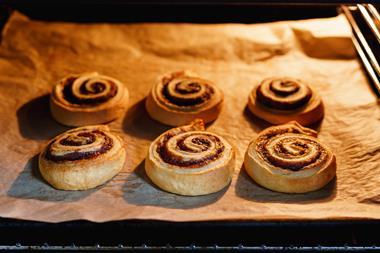Featherweight sponges, airy creams and crisp pastry – it could only be Pâtisserie Week on The Great British Bake Off.
Patisserie is, for many, the blue ribbon category of baking, as bakers employ enormous delicacy and mastery of technical skill to produce moments of pure mouth magic.
We asked Mikael Bougault, who trained under the famous pâtissier Frederic Cassel and is now head of patisserie at Brighton’s Real Pâtisserie, Western Road, for his thoughts on the challenges facing the contestants.
This week’s signature challenge is to produce 24 cream horns in two different flavours. There is plenty of ambition on show as one contestant attempts to produce two different pastries.
If one of those is puff, Bougault warns the baker to be careful when rolling the butter into the pastry mix.
He says: “They have got to be careful the butter doesn’t go through the puff pastry.”
Bougault is also uncertain about another brave baker’s decision to make a banana and custard filling.
“Simple is better,” he says.
It is Mary Berry’s turn to set the technical challenge and she has chosen mokatines, squares of light Genoese sponge filled with coffee buttercream and decorated with two types of icing.
Genoese sponge can be very tricky as it relies on air beaten into the mixture to add volume to the cake as opposed to chemical raising agents.
“It’s a sponge we use for the wedding cake and fraisier,” says Bougault.
He says the eggs and the sugar need to be beaten over a bain-marie at 60˚C at the start of the process before the flour is folded in, so an ability to manage temperatures will be required to achieve perfect consistency.
A towering showstopper will bring this week’s show to a close as the bakers produce a religieuse à l’ancienne. A tower made of three tiers of éclairs filled with crème pâtissière and decorated with buttercream, it is a challenge which makes even Bougault pause. The first challenge is the choux pastry.
“It’s hard for me to do,” says Bougault, adding: “For this, it’s the temperature of the oven. If it’s too hot, the choux buns explode.”
If the bakers elect to make traditional French buttercream, a more complicated version of the common butter-and-icing-sugar frosting, which involves eggs, Bougault warns that temperature control is key.
If the butter is added to too cold a mixture it will be heavy but too hot and it will be “like soup”.
As a parting shot, Bougault warns the bakers to be careful about working in a strange kitchen as different ovens and machines can produce completely different results with exactly the same ingredients.
“It’s all about testing when you have a new machine,” he says: “You have to test everything.”


























No comments yet